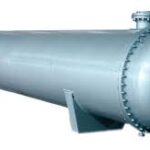Shell and Tube Condenser
Shell and Tube Condenser is a type of heat exchanger used to condense steam or vapor into liquid. It consists of a series of tubes enclosed within a cylindrical shell. One fluid flows through the tubes, while another fluid flows over the tubes within the shell, facilitating heat transfer and condensation. This design is commonly used in industrial processes, power plants, and HVAC systems due to its efficiency and capacity to handle high pressure and temperature.

Shell and Tube Condenser
Function of
- Heat Transfer Efficiency: This is determined by the surface area of the tubes, the thermal conductivity of the materials, and the flow characteristics. Efficient heat transfer requires maximizing the contact surface area and using materials with high thermal conductivity.
- Material Selection: The materials used for the shell and tubes must resist corrosion and withstand high temperatures and pressures. Common materials include stainless steel, copper, and titanium, chosen based on the working environment and fluids involved.
- Flow Arrangement: The arrangement of fluid flow can be counterflow, parallel flow, or crossflow. Counterflow, where fluids move in opposite directions, typically offers the highest efficiency by maintaining a larger temperature gradient along the length of the exchanger.
- Tube Diameter and Length: The diameter and length of the tubes impact the surface area available for heat transfer and the pressure drop across the condenser. Larger diameter tubes provide more surface area but can increase the pressure drop.
- Shell and Tube Layout: The arrangement and spacing of tubes within the shell influence the flow dynamics and heat exchange efficiency. Baffle plates are often used to direct the fluid flow across the tubes, enhancing turbulence and heat transfer.
- Maintenance Accessibility: The design should allow for easy cleaning and maintenance to prevent fouling and scaling, which can significantly reduce efficiency. Removable tube bundles and easy access points facilitate regular maintenance.
Shell and Tube Condenser
Application of
- Condense exhaust steam from turbines to improve efficiency by recycling water.
- Condense refrigerant gases to aid in cooling processes, used in large-scale installations.
- Condense vapors and recover solvents in distillation and chemical processes.
- Condense refrigerants to remove heat from cooling systems, use
- in industrial and commercial settings.
- Pharmaceutical Industry: Condense solvents and chemicals to ensure product purity and recovery in manufacturing processes.
- Desalination Plants: Condense steam to recover fresh water from seawater, crucial for producing potable water in arid regions.
Shell and Tube Condenser
Mode of Operation
- Fluid Flow: Two fluids are involved: the primary fluid (often steam or vapor) that needs to be condensed and the secondary fluid (usually water or a coolant) that absorbs the heat from the primary fluid.
- Heat Exchange: The primary fluid enters the condenser as hot vapor or steam. It flows through the tubes inside the condenser shell while the secondary fluid flows over the outside of the tubes.
- Condensation: As the hot vapor or steam passes through the tubes, it loses heat to the cooler secondary fluid flowing over the tubes. This causes the vapor to condense into liquid form.
- Cooling: The secondary fluid absorbs the heat from the primary fluid and exits the condenser as warmed fluid or sometimes as vapor, depending on the application.
Other Heat Exchanger We Manufacture
Shell and Tube Evaporator
Evaporator is a device used in refrigeration and air conditioning systems to absorb heat from its surroundings and evaporate a refrigerant. It operates by allowing the refrigerant
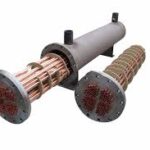
Shell and Tube After Coolers
Shell and Tube After Coolers are heat exchangers designed to cool compressed air or gases after they have been compressed by a compressor they consist of a bundle of tubes
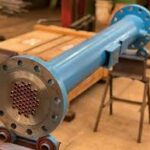
Shell and Tube Inter Coolers
Shell and Tube Inter Coolers is a type of heat exchanger commonly used in various industrial applications to cool fluids or gases. It consists of a series of tubes (tube bundle)
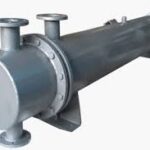
Shell and Tube Oil Coolers
Shell and Tube Oil Coolers are a type of heat exchanger commonly used in industrial applications to cool oil. These coolers consist of a series of tubes (tube bundle)
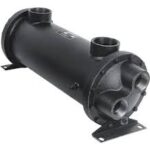
Removable Tube Heat Exchanger
Removable Tube Heat Exchanger is a heat exchanger designed with components that can be easily disassembled for maintenance, inspection, and cleaning.
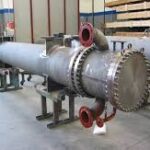
Fixed Tube Heat Exchangers
The Fixed Tube Sheet Heat Exchanger has a stationary tube sheet, securing heat exchange tubes for stability and integrity. It’s ideal for industrial applications
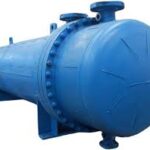
Tube Bundle Heat Exchanger
Tube Bundles are assemblies of multiple tubes, held together by tube sheets at either end. They are primarily used in shell and tube heat exchangers
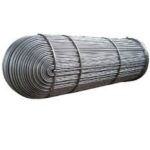
U-Tube Heat Exchanger
U-tube Heat Exchangers have U-shaped tubes that allow for thermal expansion and contraction, reducing stress. Efficient for high temperatures and pressures,
